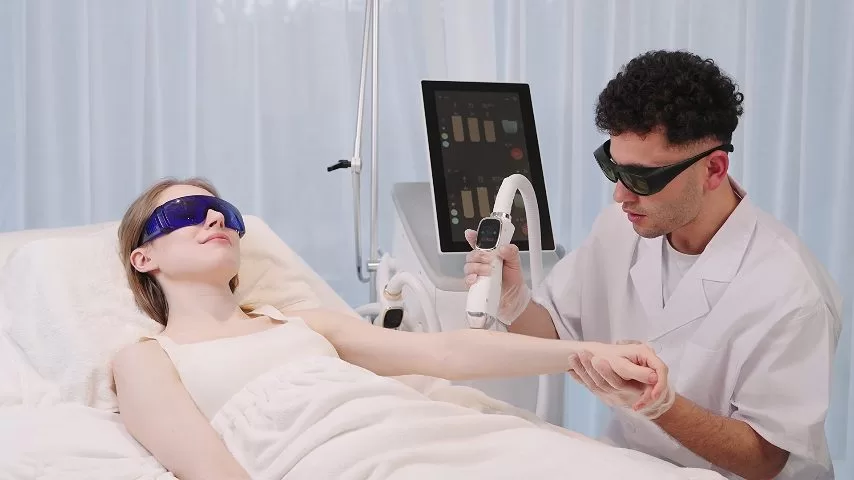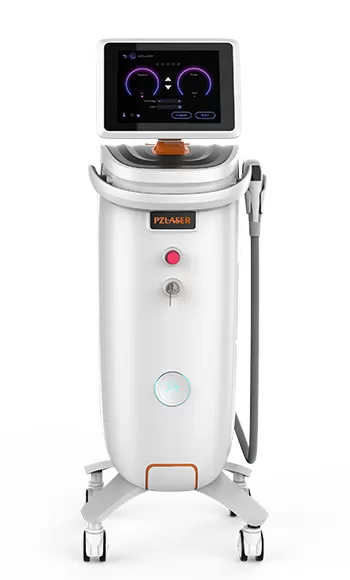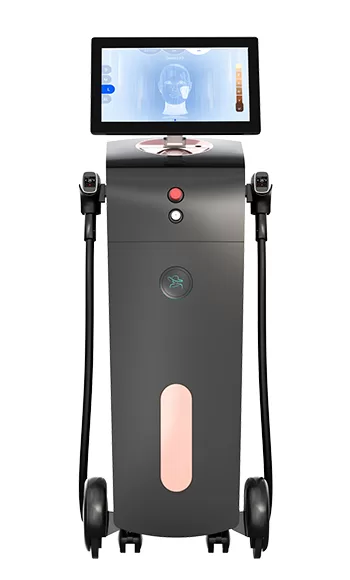Introduction

According to the regulations of the U.S. Food and Drug Administratio (FDA), electrosurgical treatment (high-frequency electrotherapy, electrolysis, electrocautery treatment, etc.), diode hair removal laser treatment (including wrinkle removal, hair removal, scar removal, etc.), intense pulsed light (IPL) treatment (including wrinkle removal, elimination of skin laxity, hair removal, etc.) are all medical beauty projects and require physician operation.
Treatment Principle of Diode Hair Removal Laser
Like the treatment of spots and blood vessels, laser hair removal is also based on the principle of selective photothermal action. When the laser penetrates deep into the dermis, the melanin in the hair follicles and hair shafts will selectively absorb the laser, thereby generating heat. But unlike treating spots and blood vessels, the pulse width of the laser used for hair removal is wider than the thermal diffusion time of melanin because our target tissue is not melanin. Current research suggests that the highly differentiated hair matrix cells (called matrix above the dermal papilla) and the hair follicle stem cells in the hair follicle protuberance are the three important target tissues for permanent hair removal. The thermal diffusion time of hair follicles is 40-100ms. The heat energy diffused from melanin is conducted from the hair shaft to the stem cells of the hair bulb outer sheath, destroying the hair follicle's germinal layer, thereby achieving the purpose of accurately destroying the hair follicle structure.
Selection and Operation of Laser Hair Removal Equipment
Currently, several commonly used hair removal equipment are available on the market, including 810nm diode laser hair removal equipment, long pulse 755nm alexandrite laser hair removal equipment, intense pulsed light hair removal equipment, and long pulse 1064nm Nd: YAG laser hair removal equipment. Let’s explore representative equipment and operating points.
1. 808nm Diode Hair Removal Laser
With a wavelength between 800 and 810nm, it ranks among the most commonly used hair removal equipment. The most commonly used hair removal equipment are all diode lasers. Traditionally, darker skin utilizes the 810nm band. It has moderate absorption of melanin, making it more friendly to people with darker skin tones. The commonly used "freezing point hair removal" mostly uses the sliding method. Due to the thermal conductivity of the gel and the sapphire cooling head, customers usually feel better. In terms of parameter setting, just follow the icons on the operation interface to perform settings. Usually, the energy density is 10-13J/cm². Do not follow the operation interface for single-part operations. The treatment takes about 30–40 seconds. Otherwise, the risk of burns is relatively high. This type of equipment is suitable for hair removal on large areas such as the chest, back, limbs, etc., and has good comfort.
Operation skills: The treatment head is vertical, close to the skin, and applies a certain amount of force. Diode hair removal is generally used for larger areas, and the local area (upper arms/calves/thighs) can be divided into three areas. During treatment, the gel needs to be added and replaced to facilitate heat dissipation. During treatment, slide quickly without pausing. Parts with thinner skin will slide faster.


2. 755nm Alexandrite Laser Hair Removal Equipment
It is one of the most effective hair removal laser devices and has many clinical applications. After the melanin in the hair follicle tissue selectively absorbs energy, the temperature rises sharply in a short period of time. Thus causing the degeneration, atrophy, and destruction of the hair follicle tissue, thereby achieving the purpose of hair removal. The most commonly used one is EOSICE® from PZLASER. This equipment has several advantages.
Firstly, it emits a stable 755nm wavelength laser, maximizing melanin absorption in hair follicles for effective treatment. Secondly, its cooling system ensures simultaneous cooling with each laser emission, enhancing treatment comfort and safety. Thirdly, it offers adjustable spot sizes ranging from 3-18mm, facilitating treatment in various areas. Typically, a spot size of 18mm is used. Fourthly, pulse width and interval adjustments accommodate diverse skin types and hair thicknesses. Recommended settings include a pulse width of 5~10ms, a pulse interval of 20ms, and an energy density of 8-10J/cm², ensuring efficacy across all hair types. Lastly, the emission of laser through the air minimizes the risk of cross-infection. This equipment is ideal for precise hair removal in small or private areas.
3. 1064nm Nd: YAG Laser Hair Removal Equipment
Due to the wavelength, the long pulse width 1064nm Nd:YAG laser penetrates deeply and can reach deep into the hair follicles; Compared with 755nm and 810nm, the selective absorption rate of 1064nm light by melanin is much lower, so the long pulse width 1064 nm Nd: YAG laser can penetrate the epidermis well and reach the subcutaneous and hair follicles. Treatment for dark skin (types IV to VI) can tolerate higher laser energy, with fewer complications and good immediate results. In addition, in the treatment of blackheads on the nose, many customers think that the blackheads are actually accompanied by enlarged nose hairs, which can also be treated with long pulse width 1064nm Nd: YAG. The parameters are approximately pulse width 25ms, light spot 2mm, and energy 35J/cm².
4. IPL Laser Hair Removal Equipment
IPL(Intense pulsed light) does not belong to the category of laser, but it is widely used in our work. The pulse width of the intense pulsed light is at the millisecond level, and the peak wavelength of the 695nm filter can penetrate deep into the hair follicles, giving enough energy and long enough pulse width to the melanin in the hair follicles to remove hair. In some institutions with less equipment, intense pulsed light can replace diode hair removal laser equipment for hair removal treatment to a certain extent. The parameters for intense pulsed light hair removal are 695nm wavelength, 20ms pulse interval, and 10°C cooling.
Adverse Reactions of Diode Hair Removal Laser Treatment
Pain during laser hair removal, including discomfort from thick hair shafts, dark skin, or skin spots, is common. Modern hair removal equipment has cooling devices to reduce pain. To minimize discomfort, it's best to remove hair before treatment, leaving only stubble. Avoid treating areas with stains or trauma. During diode hair removal laser treatment, apply slightly thicker gel but avoid repeatedly sliding over the same area multiple times.
Reactions such as erythema and perifollicular edema are normal treatment reactions, and can even be said to be end-point reactions of effective parameters. The degree and duration of erythema and edema are directly proportional to the treatment energy and treatment time, and are inevitably related to the customer's skin color. Usually, the erythema and edema around the hair follicles can subside on their own after a period of time. We strengthen cooling during the operation, apply cold compress immediately after the operation, and use topical glucocorticoid cream or ointment if necessary. At the same time, inform customers of possible erythema, hair follicle edema, etc. Due to the different requirements of customers, many customers have no expectations for the adverse reactions after hair removal. While communicating, we can appropriately reduce the energy and number of repetitions according to the customer's requirements.
Other serious complications: Laser hair removal is generally very safe. Occasionally, serious complications such as burns and discoloration require us to control equipment parameters and end-point reactions. Hair removal is not a one-time project, so there is no need to blindly increase energy. There are occasional reports of patients inducing hair growth after laser hair removal. I personally think that it is similar to the principle of hair growth laser treatment. Too low energy promotes local blood flow and metabolism of the hair, thereby promoting hair growth. In this case, you can try to increase energy and treatment times.
Conclusion
Based on the principle of selective photothermal action, laser hair removal has changed the landscape in medical aesthetics, enabling safe and effective treatment of a wide range of skin types and hair removal needs. Learning the differences in different lasers: 808nm diode laser, 755nm Alexandrite laser, 1064nm Nd: YAG laser, and IPL equipment educates practitioners to use the devices appropriately to ensure optimal efficacy and minimal risks.
Choosing the right equipment, meticulous parameter tuning, and strict protocol compliance are key to the safety and efficacy of treatments. By appropriately communicating, cooling techniques, and post-treatment care, we can also minimize adverse reactions to ensure client satisfaction and treatment longevity.
Ultimately, the importance of medical expertise, safety precautions, and ongoing innovations in laser hair removal cannot be overstated, as it is a science-driven, dynamic field that needs to evolve with patient needs for smoother, hair-free skin.






